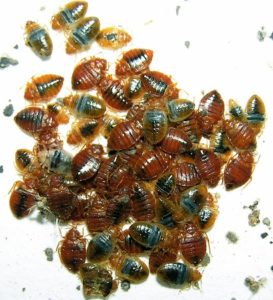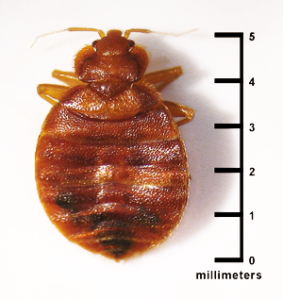Bedbugs are tiny, parasitic insects that feed on human blood. Due to the increased travel of individuals, the decrease in the use of certain pesticides and pesticide resistance, bedbugs are making a big comeback in Vanderburgh County. While bedbugs have been found to be naturally infected with several blood-borne pathogens, they are not effective vectors of disease and at this time, no infected bedbugs have been found in Vanderburgh County. The primary medical concern is inflammation associated with their bites. The Vanderburgh County Health Department has done numerous inspections and consultations for bedbugs. While we do not currently have a program available for treating homes or businesses for infestations, the Vector Control Division continues to work with and educate businesses and the general public on ways to resolve problems that bedbug infestations create.
 |
 |
|
| source of photos: A.L. Szalanski (left), CDC/CDC-DPDx Blain Matheson, (right). | ||
Prevention
Follow these steps to protect yourself from bedbugs! Be Vigilant!
- When travelling, wrap your clothes in sealed plastic bags. Black trash bags will work fine but using clear plastic bags will give you the advantage when trying to spot bedbugs.
- Carefully inspect hotel rooms before unpacking your clothes. Bedbugs don’t discriminate. They can be found in the finest hotels, as well as motels you might find on the back roads.
- Check the seams around the mattress and other tight crevices surrounding the bed. Bedbugs love tight cracks and crevices so be thorough. Bedbugs have been found between the cracks of wooden trim, baseboards, and key holes. Others have been found behind the wall plates of electrical outlets.
- Some rooms with bedbug infestations will have a strong “buggy” smell.
- Check for small dark spots along your mattress, sheets and pillows. The spots could be bedbug excrement, smears of blood, molted skin or even eggs.
- Before packing to go home, make sure you re-inspect your clothes and your luggage. The bedbugs may have eluded your earlier inspections.
- Once you get home look over the sealed bag of clothes again. If you missed finding any on your last inspection it is possible they may have settled into the corners of the bag during your trip back home. Remember to thoroughly check the crevices and pockets of your luggage.
- If you haven’t found anything by now but still need some peace of mind, put your clothes and shoes in the dryer at a medium to high setting for 10 to 20 minutes. The heat should kill all life stages including the eggs.
While all this may sound like a lot of work, keep in mind that treating a home for a bedbug infestation is a very involved and time consuming process requiring the help of a licensed pest control professional. It can be extremely expensive. Take the time to ensure you aren’t bringing bedbugs into your home.

